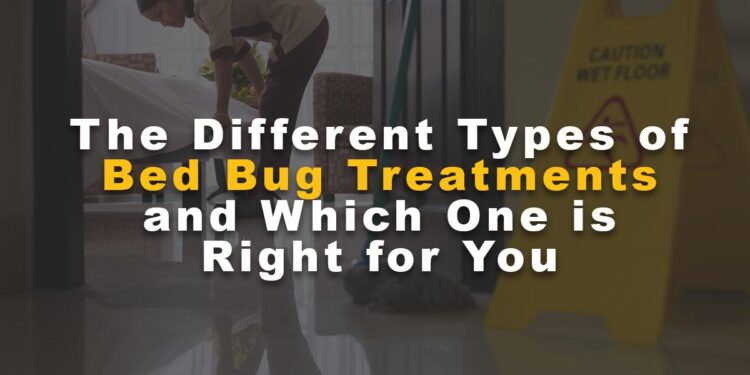Discovering a bed bug infestation can be a frustrating and unsettling experience for homeowners. These pesky little creatures can quickly take over your home, leaving you with itchy bites and stress. Treating a bed bug infestation is essential as soon as possible. But with so many treatment options available, knowing which one is right for you can be challenging. In this article, we’ll look at the various non-chemical and chemical treatment options for bed bugs and explore the factors you should consider when choosing the proper treatment for your infestation.
Non-Chemical Bed Bug Treatment Options
If you’re dealing with bed bugs, you may not want to use chemicals to eliminate them. These are the alternative bed bug treatment options that you can consider.
1. Heat Treatment
Heat treatment is a non-chemical option that uses high temperatures to kill bed bugs. Professionals use special equipment to heat a room to a temperature lethal to bed bugs, typically around 120-135 degrees Fahrenheit. This method is effective because it can reach all areas of a room, including cracks and crevices where bed bugs like to hide.
One advantage of heat treatment is that it is non-toxic and does not leave residue behind. It also kills all stages of bed bugs, from eggs to adults. However, heat treatment can be costly and may require multiple treatments to eliminate the infestation. Additionally, it’s essential to prepare the room by removing items that high temperatures may damage.
2. Freezing Treatment
Freezing treatment is another non-chemical option that uses freezing temperatures to kill bed bugs. Professionals use special equipment to freeze items, typically at -20 degrees Fahrenheit. This method is effective because it can quickly kill bed bugs and their eggs.
One advantage of freezing treatment is that it’s non-toxic and requires no preparation or cleanup. It’s also effective at killing all stages of bed bugs, including eggs. However, it can be expensive and require multiple treatments to eliminate the infestation. Additionally, it could be more suitable for larger areas, such as entire rooms.
3. Vacuuming Treatment
Utilizing a vacuum cleaner is a non-toxic solution that may effectively decrease the number of bed bugs present in your living area. It involves vacuuming all surfaces where bed bugs may hide, such as mattresses, box springs, and furniture. While vacuuming alone won’t eliminate a bed bug infestation, it can be a valuable tool in conjunction with other treatments.
One advantage of vacuuming is that it’s an affordable option that you can do yourself. A preventive measure to reduce the chances of bed bugs infesting your home is to use a vacuum. However, vacuuming alone won’t eliminate a bed bug infestation, and it’s ineffective at killing bed bug eggs.
Chemical Bed Bug Treatment Options
Chemical bed bug treatments are a popular and effective way to eliminate bed bugs. Several options are available, and these are the most common methods pest control professionals use to eradicate bed bugs from homes and other spaces.
1. Insecticide-Based Treatment
Insecticide-based treatments are one of the most commonly used chemical treatments for bed bugs. These treatments use chemicals to kill bed bugs on contact or through ingestion. You can apply insecticide-based treatments in sprays, liquids, or powders. You can use these treatments on soft and hard surfaces, such as mattresses, furniture, and walls.
One of the advantages of insecticide-based treatments is that they are relatively fast-acting and can kill bed bugs quickly. However, one of the disadvantages of these treatments is that bed bugs can become resistant to them over time. Additionally, insecticide-based therapies can harm humans and pets if not used correctly.
2. Dust-Based Treatment
Dust-based treatments are another type of chemical treatment for bed bugs. These treatments use dust that contains pesticides and insecticides to kill bed bugs. Pest control professionals typically apply dust-based treatments to cracks, crevices, and other hard-to-reach areas where bed bugs are known to hide.
One of the advantages of dust-based treatments is that they can be effective for up to several months. Additionally, one can use dust-based therapies where other chemical treatments may not be safe or practical. However, one of the disadvantages of dust-based treatments is that they can be messy and difficult to apply.
3. Fumigation Treatment
Fumigation treatments are the most aggressive type of chemical treatment for bed bugs. These treatments involve sealing the entire room or building and using fumigants to kill bed bugs. Pest control professionals use fumigation treatments for severe bed bug infestations when other treatments have proven ineffective.
One of the advantages of fumigation treatments is that they can eliminate bed bugs from all areas of the room or building, even those that are hard to reach. However, one of the disadvantages of fumigation treatments is that they can be expensive and require you to vacate your home or building for several days.
Factors to Consider in Choosing the Right Bed Bug Treatment
Choosing the proper treatment is essential when dealing with a bed bug infestation. To make an informed decision, these are the factors to consider in selecting the appropriate bed bug treatment.
1. Location and severity of infestation
Determining the location and extent of the bed bug infestation is crucial in selecting the most appropriate treatment option. For instance, a localized treatment may be sufficient if the infestation limits itself to a single room. However, more extensive treatment may be necessary if the infestation has spread to multiple rooms or throughout the entire house.
2. Size of the infected area
The size of the infected area will also affect the treatment choice. While smaller areas would need minimal treatments, larger spaces might call for more elaborate ones.
3. Sensitivity to chemicals
Bed bug treatments may involve chemicals that can affect individuals with sensitivities. It is essential to choose a bed bug treatment option that is effective yet safe, especially for individuals who have sensitivities to certain chemicals.
4. Budget
Bed bug treatments can vary in cost depending on the method used and the severity of the infestation. Choosing a treatment that is within your budget and effective in eliminating the infestation is essential.
Choose the Right Treatment
In conclusion, bed bug infestations are a severe problem that can significantly impact the quality of life of those affected. When choosing the proper bed bug treatment, like bed bug treatment in San Jose, CA, it is essential to consider factors such as the infestation’s location and severity, the infected area’s size, chemical sensitivity, and budget. The most effective course of action will vary depending on the unique circumstances of each case. Consult a pest control professional who can advise on the most effective and safe bed bug treatment options. Ultimately, taking swift and appropriate action to address bed bug infestations can help prevent the spread of these pests and minimize their impact on your home and well-being.













